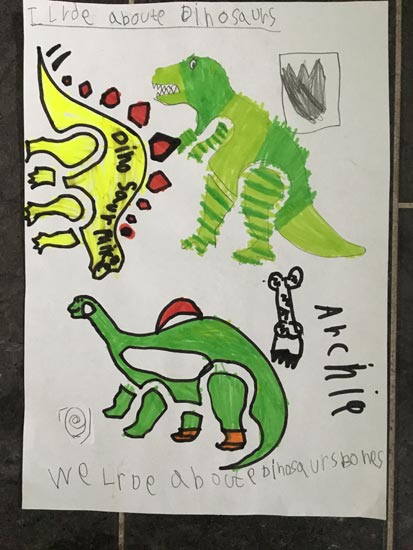Appreciating the Art of Drawing Dinosauria
In Praise of the Work of Palaeoartists
As we sit in the office struggling to get to grips with the technical wizardry of CS5 and Adobe Photoshop, trying to get to grips with drawing Dinosauria, it can be quite humbling to compare and contrast our own meagre efforts with someone who has a real gift for portraying images and showing fine detail, such as a professional illustrator. Observation is a key skill for any scientist, we stress to the students that we meet on our school visits the importance of being able to observe an object in fine detail.
Photographs are very helpful, but to get to know an object such as a piece of fossilised bone, there is no better way than observing it carefully and then trying to draw what you see.
Drawing Dinosauria
When discussing the importance of illustrations in scientific literature over a coffee, a colleague remembered being told by an old professor that in his opinion, no one actually knew or understood a specimen properly until they took the time and the trouble to draw it.
Being able to draw what you see is a rare gift, but rarer still is that ability to take scientific principles and theories about the past and then make ancient history come alive on a canvas. Palaeoartists are able to do this. They take current scientific thinking and create a scene from prehistory depicting how the fossils came to be formed, how the sauropod happened to be entombed in what was to become the Morrison Formation or how the action of a arthropod scuttling across the shoreline of a Jurassic lagoon came to be preserved as a fossil within lithographic limestone.
This takes great skill, being able to interpret and apply scientific knowledge to produce a work of art depicting a scene that vividly brings to life those animals and plants preserved in the fossil record.
One such palaeoartist is Milan born, Fabio Pastori, whose work is often featured in Prehistoric Times and a number of other leading publications. His dedication, passion for detail and exquisite eye for detail has enabled him to produce some truly outstanding illustrations. For example, the picture below entitled “The Perfect Storm” captures a dramatic moment in the life of a herd of a group of Late Jurassic sauropods, an excellent example of the fossil record being brought to life by the efforts of a talented individual.
Fabio kindly supplied some details of the original artwork:
Life like appearance of depicted taxa and surrounding habitat in traditional technique 2D: acrylics by brush on cardboard- original size: 23 x 36.7 cm ( 9.8 x 14.4 inches ).
He explains that the image illustrates a very special moment during the Late Jurassic (Kimmeridgian faunal stage) in northern Germany. This is depiction of several individuals of the genus Europasaurus in total panic feeling the approach of an storm. In a few minutes some of these unfortunate animals would be caught in a deluge of rain and swept out to sea. Whilst the herbivores panic a juvenile Theriosuchus jumps away from this commotion of dwarf sauropods, … but giants compared to his very small size.
When commenting on the composition of this particular picture Fabio states:
“The painting plays on many levels in prospective, leaving in focus just the central individual of sub-adult of Europasaurus”.
From our perspective we can only admire the care and attention to detail that Fabio displays in his artworks.
An Artist Inspires Young Artists

We received lots of colourful dinosaurs from Year 5/6. The work of Fabio Pastori inspires young artists. Picture credit: Everything Dinosaur.
Picture credit: Everything Dinosaur
To help inspire the next generation of young artists drawing the Dinosauria, visit Everything Dinosaur’s website: Everything Dinosaur.

